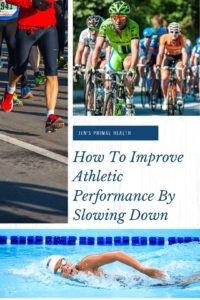I earn a small commission via affilate links at no extra cost to you.
The conventional wisdom of endurance training is rooted in the “no pain no gain” mindset. We’ve been conditioned to believe that we just need to suck it up and go harder. Then when we go harder we need to go farther. The problem is that this isn’t the best approach if you want to improve athletic performance. This approach typically reduces the number of years you can compete and it definitely doesn’t promote longevity.
Anaerobic (limited oxygen) vs Aerobic (oxygen abundant): Endurance Training and Athletic Performance
The problem lies between aerobic vs anaerobic training. Most endurance training approaches are deeply rooted in anaerobic training, that is, your heart rate is so high your body has to use stored glycogen for fuel. This is why pasta dinners before a race and sugar gels exist. What if I told you there’s a better way? What if you could train less, train at a lower intensity, and race faster?
You probably don’t believe me but stick with me.
When you train aerobically you provide your body with oxygen during your training. Why is that important? Your body needs oxygen to burn fat. The single biggest limiting factor in endurance performance is the tiny amount of glycogen the body can store. We are only able to store 1600 to 2000 calories of glycogen in our liver and muscle tissue. Conversely when you access stored body fat (say you weigh 137 lbs with 5% body fat) you can store at least 20,000 calories of energy in the form of fat. I don’t think I know anyone with 5% body fat so your caloric storage is definitely greater than 20,000 calories.
During a race or athletic event which would you rather have access to? 2,000 calories or 20,000 calories. If you want to level up your endurance training, work on using the bigger fuel tank.
Anaerobic Training & Disease Risk
Yes, you read that right. Many endurance athletes who submit to conventional wisdom with an abundance of anaerobic training are actually increasing their risk of disease. Marathoners and Triathletes typically don’t live any longer than couch potatoes. (see video below) When training day efforts are too long, too strenuous, and happen too frequently: you end up with poor performance, fatigue, stiffness, and soreness, weakened immune system, failed weight loss, an increased risk of injury, and burnout from accessing the flight or fight response too often.
How Carbohydrates & Overtraining Affect Mitochondria
Mitochondria are the powerhouses of your cells. When they burn fat they burn it much more cleanly than they do glucose. Burning glucose, due to exercise habits and/or diet, causes more free radicals to be released. This can cause your mitochondria to atrophy which in turn reduces the amount of energy your cells can produce. Overtraining has been shown to cause gene mutations that damage mitochondria.
Relying on carbohydrates as a primary fuel source generates a lot of free radical production because glucose burns quickly and easily. As you break down your mitochondria the excess carbohydrate consumption ends up stored as body fat. This is why at nearly all competitive endurance events you’ll find athletes that are heavier than you’d expect them to be.
Cortisol and The Fight or Flight Response
The aspect of exercise that makes it beneficial is the activation of the fight or flight response. When this response is activated the body releases the stress hormone cortisol. Cortisol pulls glucose out of storage and makes it available for use. It’s a handy system in the event that you need to outsmart a bear in the woods or run away from a predator. However in today’s world, most people are already stressed 24/7, especially type A, overachieving, endurance athletes who work in the corporate world.
When cortisol is chronically elevated it suppresses testosterone, growth hormone, and other adaptive hormones. That results in poor fat burning, decreases energy levels, hinders your immune function, reduces muscle development, and hinders your sex drive. Conversely, a brief bout of exercise increases testosterone & growth hormone. This allows for muscle growth and recovery, the stability of hunger hormones, feeling energetic instead of drained, and it has an anti-aging effect.
Because cortisol and excessive endurance exercise promote the inflammatory response and can lead to systemic inflammation it opens you up to a number of diseases. (Inflammation (-itis) is at the root of most disease) The continuous stress, over stress, placed on the body contributes to heart disease, cancer, osteoporosis, and hindered immune function. Recurring muscle fatigue and repetitive impact, in addition to these fight or flight hormones, traumatizes joints and soft tissues making them more susceptible to injury.
Heart Arrhythmias & Endurance Training
When you’re exercising your skeletal muscles are good at providing pain feedback. The one muscle that gets ignored because it doesn’t behave the same way is the heart. When you engage in frequent endurance training that is strenuous and is too long & frequent you can inflame and scar your arteries. Damage sustained by the right ventricle of the heart can lead to arrhythmias, atria fibrillation, and sudden death in athletes.
I know it sounds counter to the conventional “no pain no gain” approach of endurance training but your cardiovascular system is vulnerable to your stressful routine. It’s not just your workouts. When you’re carb-loading that’s inflammatory to your circulatory system as well. (Read 12 Reasons To Go Grain Free)
According to Dr. Peter Attia, president and co-founder of the Nutrition Science Initiative,
When we engage in an extreme effort like an all-out time trial, we increase both heart rate and stroke volume (the amount of blood pumped per beat of the heart), by stretching the heart larger to pump more blood per beat. This amazing organ can quickly go from pumping three to fine liters of blood around our body per minute at rest or thirty liters per minute during very intense exercise. Unfortunately, the right side of the heart, which pumps only against the low-resistance lungs, and is far less muscular than the left ventricle, is more vulnerable to damage from chronic amounts of high cardiac output training. So while short bouts of this intensity don’t appear to cause lasting damage on the heart, prolonged activity does–at least in susceptible individuals. The so-called chronic cardio patterns can cause the right ventricle to become scarred from excessive use and insufficient recovery. This scarring can lead to cardiac arrhythmias, especially atria fibrillation, and even sudden death in athletes who have no evidence of atherosclerosis.
Dr. James O’Keefe, a sports cardiologist, weighs in with his Ted Talk below:
Slower Endurance Training Develops Aerobic Training & Improves Athletic Performance
If you want to improve your athletic performance you need to slow down during your endurance training. Dr. Phil Maffetone developed the 180 – your age equation in 1982 so this isn’t new information. When you implement the Maffetone approach to your endurance exercise, you’ll discover that over time you’ll be able to go faster but keep the same low heart rate.
Plus, when you slow down you give your body the opportunity to begin burning more fat for fuel than carbohydrates. Slower endurance workouts help you access a cleaner-burning fuel and improve your performance. Dr. Maffetone says that many have had their best races by simply building their aerobic base.
Ma endurance athletes find that when they slow down to the Maffetone pace they end up walking. That is, in order to keep their heart rate below 180-age formula and not go over, their aerobic fitness is so poor they have to walk even though they’ve been competing in marathons for years. It’s an eye-opener to discover that you’re not as fit as you think you are.
If you’re taking medications or have other health issues your maximum heart rate is even lower than the 180-age equation. Am I talking about your average heart rate during your training? Nope. I’m talking about not letting your heart rate go over that number at all! The second you go beyond that number you shut off fat burning and activate glucose burning. Slightly drifting out of the aerobic zone when running up a hill will accelerate sugar burning at rest for up to 72 hours after. [1] This is the number one factor that determines what fuel you’ll use during your endurance workout.
Pair A Primal Lifestyle With Endurance Workouts
If you want to help your body maximize fat burning you have to begin cutting down on the carbohydrates in your diet. Carbohydrates metabolize into glucose and glucose suppresses fat burning. If you’re coming from the Standard American Diet (SAD) takes 3-4 weeks of consistent primal eating to begin to build the metabolic machinery so the body can remember how to access stored body fat for fuel. The longer you maintain the primal lifestyle the better your body becomes at using fat for fuel. If your endurance workouts are consistently dependent on glucose as a primary fuel source, it’s going to make fat-adaptation take longer.
I know many in the endurance training world have the belief that they do what they do so that they can make more poor food choices. Quite honestly you’re doing your body a great disservice. Not only is poor food inflammatory you’re compounding the inflammation with a “no pain no gain” endurance training regimen.
My Experience With Low Carb Endurance Training
I’ve been a Primal Health Coach since 2016 and I’m currently working my way through the Primal Endurance Mastery Course. While I’ve never been a triathlete or marathoner I have used my knowledge in my exercise routine. Do they work? The first year I went bow hunting I found myself stopping to catch my breath hiking up the hills. (About 5,000 feet elevation). When I returned the second year I found that I could easily walk up the same hills without needing to stop and catch my breath.
In 2019, at the age of 44, I decided to take up Taekwondo even though I have autoimmune joint pain. While there aren’t a lot of people my age in class I will say that I’ve seen more come and go quickly when they begin at my age. I’ve also been able to hang with the cardiovascular fitness of the 20 somethings and sometimes I can outbreathe them. It’s made breathing one of my fighting strategies. If your opponent can’t breathe it allows you to get more kicks in.
Conversely, in my 20’s I went to a kickboxing step class 5 nights a week because I genuinely enjoyed the class. Then some nights I’d follow that up with weight lifting. Over the course of a year, I put on 30 lbs. For years I told myself that I was buff but looking back I was pudgy fit. When my 1990’s baggy jeans were struggling at the seams and I felt I needed bigger pants I quit the gym. I didn’t change how I was eating, I simply quit my chronic cardio pace, and I returned to my normal size. Now, I’m about 5 lbs of that heavyweight but I wear the smallest size I’ve ever worn. What you’re made of is more important than what you weigh.
What I’m saying is that I’ve done the chronic exercise routine in the past. I’d eat on the way to work, again at 10, noon, 2, 4, I’d have a snack before I made dinner, eat dinner, and then a snack before bed. My body was running on glucose and every little dip in blood sugar made me hungry. Now, I eat twice a day and I’m not hungry outside those widows. On my elk hunt, I had beef organ capsules for breakfast and I added electrolytes to my hydration bag. I didn’t eat lunch until about 2 pm. Knowing I had to hike about 1,000 feet up and down the mountain with elk on my back I figured it might be wise to eat, just cuz.
Should You Completely Abandon Anaerobic Training?
No. Anaerobic training has its place, which I’ll discuss in another post, but it shouldn’t be the bulk of your endurance workouts. You need a sensible, balanced approach to endurance exercise. If you’re happy with your body composition, athletic performance, energy levels, you’re not stressed out, you don’t experience recurring injuries, and you keep reaching new personal records then you’re doing something right. If your best PR was years ago and you haven’t hit one since then it’s a sign that something you’re doing is off.
[1] Primal Endurance by Mark Sisson and Brad Kerns
Originally posted on February 5, 2020 @ 13:16




